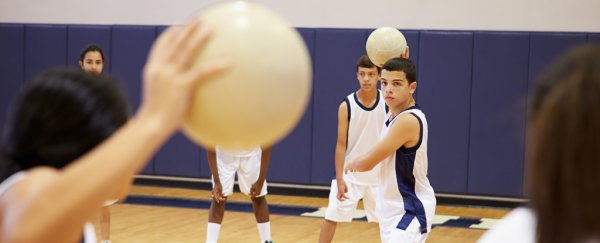One of gym classes' most common games is being used as a tool of "oppression", according to a team of Canadian researchers.
Dodgeball in phys-ed classes teaches students to dehumanize and harm their peers, professors from three Canadian universities said in a presentation this week at the Congress of the Humanities and Social Sciences in Vancouver.
A paper on the subject is set to appear in the journal European Physical Education Review.
"When you're setting up the environment for students to learn, and you introduce the idea that it's okay to slam the ball at whomever you like, even if it's with a soft ball, the intention is there," Joy Butler, a professor who studies pedagogy and curriculum development at University of British Columbia, said in a phone interview.
"When students think it's okay because they're being told it's okay to do that, what do they learn? People say [dodgeball] is being used as an outlet for aggression or catharsis. I suspect that this is where they're learning that.
"[Physical education class] should be an arena where teachers are helping [students] control their aggression and move on instead of expressing themselves through anger."
Researchers set out to interview middle-school-age students about broader questions in physical education courses, but kept hearing the same thing from certain students: They hated dodgeball.
Interviewers dug deeper, asking students why, then plotted the answers against political theorist Iris Marion Young's Five Faces of Oppression, an article published in her 1990 book Justice and the Politics of Difference.
Young argues oppression's faces are:
- Exploitation: Using other people's labors to benefit for oneself.
- Marginalization: Relegating a group of lower standing to the edge of society.
- Powerlessness: Those relegated have a lack autonomy.
- Cultural imperialism: Establishing the rules and customs of the ruling class as the norm.
- Violence: Members of a group of lower standing know they may be subject to random, unprovoked attacks.
Those matched up with some of the underlying messages students communicated to researchers, Butler said.
"I think of the little girl who is running to the back to avoid being targeted," Butler said. "What is she learning in that class? Avoidance?"
Researchers observed the more athletic and authoritative students in the class established rules and practices without input from other students, including creating their own teams, which allowed them to gang up on other students.
"The message is that it's okay to hurt or dehumanize the 'other,' " Butler said.
"The competition is about annihilating one's opponent, and the true definition of competition is between two evenly matched teams. Well, kids stack their teams, and they really enjoy beating the other team. What's the enjoyment of that?"
When Butler in a focus group asked a class to create a brand new game - the only requirements were that it involved a ball and two goals and that the entire class had to form a consensus about the rules - the same group of students split off to develop a game without consulting peers. She said that showed the culture established by dodgeball spills into other activities in physical education.
That's troubling, she said, because many Canadian schools are making great strides to improve phys-ed classes. Administrators are taking solid steps to reverse the trend of girls dropping out of P.E. classes. More courses focus on health, wellness and fitness, and not just sports.
Gym classes are largely centered around games, she said, which is can be great, but can also exclude students with different strengths.
"If one thing were to come out of this it would be for P.E. teachers to look at their curriculums and look for balance," she said. "And that could mean dropping games and including other activities: outdoor education, fitness, gymnastics, aquatics."
To Butler, it also means getting rid of dodgeball.
2019 © The Washington Post
This article was originally published by The Washington Post.
